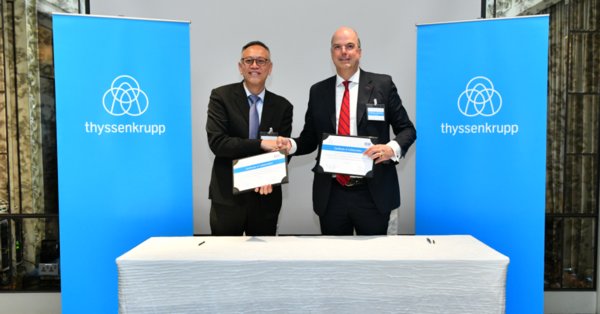SINGAPORE, July 2, 2019 /PRNewswire/ -- thyssenkrupp today presented a white paper on additive manufacturing (AM) potential in the ASEAN region, a comprehensive research undertaken by the company as a prelude to the official launch of its AM TechCenter Hub in Singapore.

Titled "Additive Manufacturing: Adding Up Growth Opportunities for ASEAN", the white paper provides deep insights and perspectives on the state of additive manufacturing in the ten member countries of ASEAN. The paper was developed by thyssenkrupp with the support and contribution of a multidisciplinary team of experts and partners in Singapore including the global industrial 3D printing leader EOS GmbH and the National Additive Manufacturing Innovation Cluster (NAMIC).
The research shared exciting prospects for additive manufacturing in the ASEAN region, where current penetration is still relatively low despite wider acceptance globally. The extensive study noted several key highlights:
It can also contribute in sustainable development and improve ASEAN's competitiveness in already established global value chains across key sectors such as Automotive, Electronics, and Chemicals, as well as accelerate the region's growth in industries like Aerospace, Medical Devices, and Healthcare.
Additive manufacturing would enable the ASEAN region to further advance its Industry 4.0 and skills development focus, and promote local entrepreneurship with the potential to create 3 to 4 million additional AM jobs for the region by 2030.
"As our study shows, additive manufacturing delivers enormous potential to transform the ASEAN region and level up vital sectors," said Mr Jan Lueder, CEO of thyssenkrupp Regional Headquarters Asia Pacific. "Additive manufacturing will surely be an innovative solution to further drive growth in ASEAN, as long as stakeholders work together to continue building awareness as well as a supportive ecosystem for additive manufacturing adoption and development. We have found such an ecosystem in Singapore, and that is one of the key reasons in establishing our first additive manufacturing TechCenter Hub outside of Germany."
Establishment of thyssenkrupp's Additive Manufacturing TechCenter Hub in Singapore
The white paper comes at the heels of the establishment of thyssenkrupp's Additive Manufacturing TechCenter Hub in Singapore. The TechCenter Hub, supported by the Singapore Economic Development Board (EDB), serves as the regional hub for the company's existing TechCenter in Mulheim an der Ruhr in Germany. The Singapore Hub, along with the Mulheim TechCenter, will focus on innovations around additive manufacturing solutions in metal and plastic technologies for customers in marine and offshore, automotive, cement, chemical, mining and other heavy industries.
The presentation of the research was held at the official launch of the Singapore AM TechCenter Hub, which was attended by top executives from thyssenkrupp AG, representatives from the Singapore Economic Development Board, and key business partners and customers of thyssenkrupp in Asia Pacific. The launch was formally marked with a signing ceremony presided by Dr Donatus Kaufmann, Executive Board Member of thyssenkrupp AG, and Mr Lim Kok Kiang, Assistant Managing Director, EDB.
"Our Additive Manufacturing TechCenter in Germany has been at the forefront of many innovations in AM," shared Mr Lueder, "and we aim to bring these important and transformative innovations to our customers in the Asia Pacific region via the Singapore hub."
"Singapore has invested more than $200 million in additive manufacturing-related research, to develop new capabilities that can better serve the growing demand in Southeast Asia. thyssenkrupp's Singapore AM TechCentre Hub is an exciting and timely addition to our efforts in this area, leveraging our diverse manufacturing base and strengths in Industry 4.0 to create innovative solutions for its customers, from Singapore. We look forward to working with thyssenkrupp in strengthening our status as an additive manufacturing hub for Asia Pacific," said Mr Lim.
ASEAN's ten member countries have varying degrees of additive manufacturing adoption, with many of these focused on developing the infrastructure and skills to leverage on this disruptive technology. Currently, Singapore has around 40% of the additive manufacturing market in ASEAN, followed by Malaysia and Thailand with the next 40% of the market by value. The research further indicates that along with a better understanding of additive manufacturing, its use and commercial value, partnerships and collaborations will be effective means to push for broader acceptance of the technology in the region.
"The biggest roadblock for additive manufacturing adoption is not the technology but lack of know-how today, and this is where we can create value for our customers building on our deep AM expertise," said Mr Abhinav Singhal, Chief Strategy Officer for thyssenkrupp Regional Headquarters Asia Pacific and one of the authors of the white paper. "We believe that all stakeholders -- governments, businesses, research institutions -- should come together and harness the potential of additive manufacturing to truly transform the region's industries and realize our shared vision of growth and development. The time to act is now."
About thyssenkrupp:
thyssenkrupp is a technology group with traditional strengths in materials. Over 160,000 employees in 78 countries work with passion and technological know-how to develop high-quality products and intelligent industrial processes and services for sustainable progress. Their skills and commitment are the basis of our success. In fiscal year 2017/2018 thyssenkrupp generated sales of EUR42.7 billion.
Together with our customers we develop competitive solutions for future challenges in their respective industries. With our engineering expertise we enable our customers to gain an edge in the global market and manufacture innovative products in a cost- and resource-friendly way. Our technologies and innovations are the key to meeting diverse customer and market requirements around the world, growing on the markets of the future, and generating strong and stable earnings, cash flows and value growth.
Photo - https://photos.prnasia.com/prnh/20190702/2515028-1-a
Photo - https://photos.prnasia.com/prnh/20190702/2515028-1-b